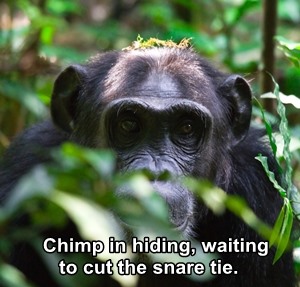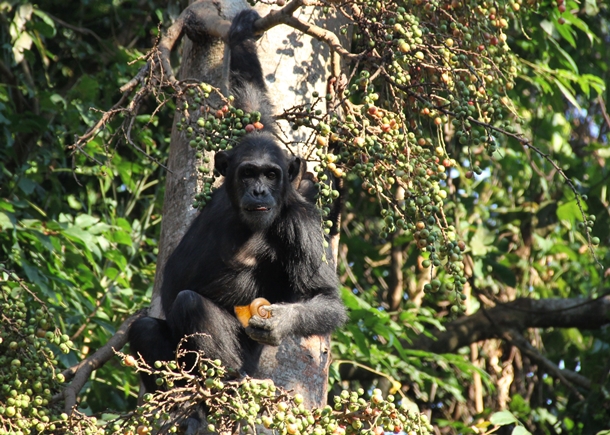 The discovery last year of a new and thriving colony of chimpanzees in the remote Bili-Uele forest in Northern Congo has proved to offer a unique opportunity for research into man’s nearest living relative. Covering an area of over 50,000 sq.km, and with an estimated chimp population in the tens of thousands, it’s given a remarkable insight into how these primate live and behave when isolated from human interaction and conflict.
The discovery last year of a new and thriving colony of chimpanzees in the remote Bili-Uele forest in Northern Congo has proved to offer a unique opportunity for research into man’s nearest living relative. Covering an area of over 50,000 sq.km, and with an estimated chimp population in the tens of thousands, it’s given a remarkable insight into how these primate live and behave when isolated from human interaction and conflict.
Initial research indicated fairly advanced group organisation, with leopards being caught and eaten and the wide-spread use of tools, but the true extent of these skills was only revealed this week to the amazement of all primatologists.
The report was compiled by a team from the University of Hapsburg, who lived in the forest for nearly six months. It has presented evidence that the culture of the Congo chimps is far advanced of their cousins in Uganda, Rwanda and Tanzania.
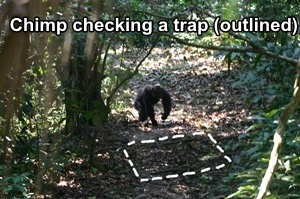 “We realised that we were dealing with a very special community on day one,” Dr. Gerald Witz, the expedition leader said. “We were setting up night camera traps when one of our party fell into large hole that was covered in branches and leaves. We assumed it was a burrow for some kind of hog until the cameras later showed us footage of the chimps repairing the damage we’d made. Two nights later an antelope fell in and the chimps returned to kill it and drag it off. It was an intentional trap.”
“We realised that we were dealing with a very special community on day one,” Dr. Gerald Witz, the expedition leader said. “We were setting up night camera traps when one of our party fell into large hole that was covered in branches and leaves. We assumed it was a burrow for some kind of hog until the cameras later showed us footage of the chimps repairing the damage we’d made. Two nights later an antelope fell in and the chimps returned to kill it and drag it off. It was an intentional trap.”
Other hunting devices included a basic snare whereby a large group of chimps climb a young sapling, weighing it down while others lashed it down with vine. It is then attached to a large loop of 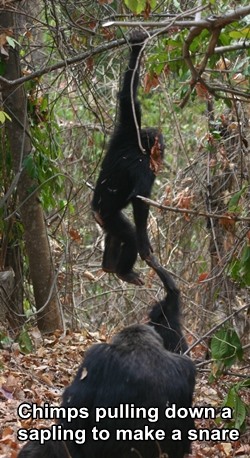 flexible bark strips twisted together. “One chimp would sit by the end of the tree, seeming to act as bait. When an animal came by, either an antelope grazing or a leopard attracted by the scent of the chimp, it would wait until it was in the trap before cutting the vine with the sharp edge of a giant snail shell. We filmed them catch two leopards this way, the trapped creature being dispatched by other chimps who’d rush forward with branches it used as clubs.”
flexible bark strips twisted together. “One chimp would sit by the end of the tree, seeming to act as bait. When an animal came by, either an antelope grazing or a leopard attracted by the scent of the chimp, it would wait until it was in the trap before cutting the vine with the sharp edge of a giant snail shell. We filmed them catch two leopards this way, the trapped creature being dispatched by other chimps who’d rush forward with branches it used as clubs.”
These giant snail shells were also observed being used in other ways – as drinking cups. “We knew the chimps enjoyed eating these large snails, but hadn’t realised how they’d adapted to use their empty shells. Over the duration of their study they saw them used as drinking cups, storage vessels for seeds and fruit and as tools for digging the traps.
It was how they lived that most impressed researchers “The chimps have very different domestic arrangements than those in East Africa,” Dr. Witz revealed. “Until now they’ve only been observed making 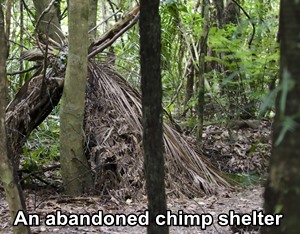 simple nests out of leaves in trees in order to keep dry and safe while sleeping. Here we found communities of basic dwellings on the ground, made from a frame of dead wood tied to the trunk of a tree, covered in woven palm fronds. Each hut had two entrances. One to allow the chimps to walk in and out and another that seemed to be an emergency escape, allowing the chimps to climb through the roof and straight up into the safety of the canopy.”
simple nests out of leaves in trees in order to keep dry and safe while sleeping. Here we found communities of basic dwellings on the ground, made from a frame of dead wood tied to the trunk of a tree, covered in woven palm fronds. Each hut had two entrances. One to allow the chimps to walk in and out and another that seemed to be an emergency escape, allowing the chimps to climb through the roof and straight up into the safety of the canopy.”
It was the chimp’s ability to frighten potential predators that allowed the chimps to live as they did. “If leopards are afraid of you, rather than vice versa, you do not have to live hiding in trees. We also observed long drop toilets and a system of bamboo used to bring water to near several of the settlements to make a basic shower facility.”
